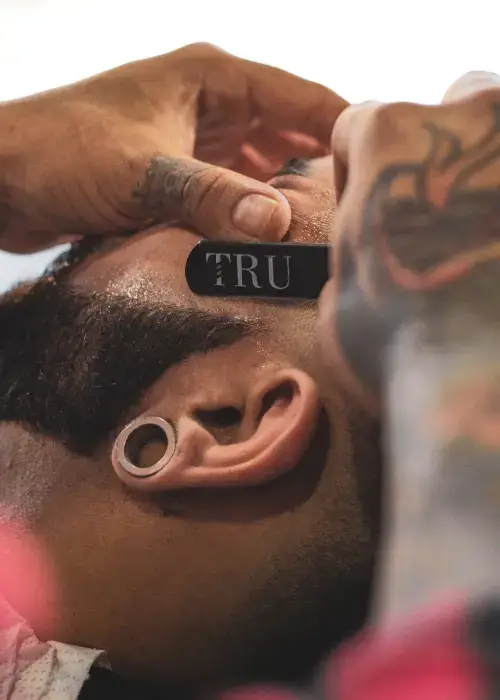Discover the Perfect Barbering Experience
Your journey to finding the ultimate barbering experience has just begun! Imagine a place where stunning visuals meet seamless communication. Our dynamic layout leads with text on the left and pairs it with eye-catching images on the right, ensuring your story gets told without compromise. Let’s delve into the unique aspects of this design:
Layout analysis
This innovative design employs a multi-column structure, championing clarity and aesthetics. With expansive text on the left and carefully curated images on the right, it strikes a perfect balance.
Overall structure
- Text-column paired with a vertical image display offers every detail spacious freedom.
- Rows and columns are arranged to please the eye while offering essential descriptions.
- The asymmetrical layout makes the contrast between content and visuals breathtaking.
Element and feature description
Visible elements
From bold headers to engaging descriptions, the layout ensures every detail shines. Three captivating images tell the visual story of the classic barber experience.
Bold action buttons like “Get directions” and “Book a cut” make interaction seamless, leading users into action.
Interactive elements and typography
Designed for clarity and function, headers employ bold fonts to grab attention, while paragraphs remain easy to read with standard fonts.
Image features
Images come framed with precise borders, absent of overwhelming overlays, offering an elegant and clean aesthetic.
Unique design aspects
The dark background-paired with light, bold text-offers a dramatic contrast for improved readability. Its simplicity thrives without hover effects or animations, keeping focus intact. Fits across any device with its responsive design.
Overall design style
This design exudes minimalism, drawing attention straight to the substance. The white space usage ensures a clutter-free, balanced view, highlighting key content with purpose.
Ten ways to organise content in WordPress
1. Categories and tags
Organising content starts with categorising and tagging. Categories group vast topics under umbrellas while tags pinpoint specifics. Consider categories as themes and tags as hashtags. Using them correctly enhances user navigation and improves search engine optimisation.
2. Custom post types
Step beyond regular posts and pages with custom post types. By creating tailored structures for content like portfolios, testimonials, or products, you can enhance your WordPress website‘s functionality and user experience.
3. Menus and submenus
Organised navigation is crucial. With well-arranged menus and submenus, users can find content easily. Ensure both main topics and sub-points are intuitively organised for easy access.
4. Custom fields
Custom fields tackle specific content needs by adding extra metadata to your posts. Use these to maintain structured and consistent content presentation across your WordPress website.
5. Internal linking
Strengthen content connections with internal linking. These links form bridges between your pages and posts, enabling search engines and readers to explore your site effortlessly.
6. Page hierarchy
Order is key to structured content. Use a parent-child page hierarchy to systematically arrange related content, enhancing contextual continuity and delivering a logical navigation flow.
7. Custom taxonomies
Boost organisation with custom taxonomies. Like an extension of categories and tags, taxonomies offer another dimension for segmenting content into meaningful groups, specifically designed for your site’s needs.
8. Content templates
Effortlessly maintain consistency across posts with content templates. Templates act as blueprints, ensuring branding and structure remain uniform, saving time while maximising impact.
9. Post archives
Useful for content-heavy sites, archives provide an intuitive solution for showcasing vast amounts of posts. Filter them by date, author, or another metric for straightforward access to historical content.
10. Sidebars and widgets
Use sidebars and widgets for quick-links or snippets of related content. Strategically placed, these elements can assist in navigation, highlight important items or add quick tools like search bars.
Ten different types of content in WordPress
1. Blog posts
The quintessential type of content, blog posts offer diverse expression for any topic. From news updates to niche musings, they’re a constant in content marketing.
2. Pages
Pages offer static content: think “About Us”. Unlike posts, they’re timeless and unrestricted by chronological order-essential for core messages and contact information.
3. Portfolios
Designed to showcase your finest work vividly, portfolio pages highlight pieces or projects. They’re crucial for freelancers aiming to present skills and successes beautifully.
4. Testimonials
Harness customer feedback by creating dedicated testimonial pages. Positive experiences written by your clients enhance credibility and instil trust among potential customers.
5. Events
Detail upcoming happenings with event posts. Use these for scheduling and informing interested parties about times, dates, and specifics, encouraging community and participation.
6. Products
Online stores use product pages extensively. Each contains detailed specifics, customer reviews, and purchasing options to facilitate smooth e-commerce operations.
7. Galleries
Communicate visually with galleries. Ideal for photographers and creatives, galleries allow image collections to be displayed professionally and beautifully.
8. FAQs
Consolidate common queries into a Frequently Asked Questions page. An organised approach here decreases repetitive inquiries and increases user satisfaction.
9. Forms
Essential for collecting user data, forms facilitate communication and interaction. Design them for ease and efficiency, prioritising user experience.
10. Case studies
Detailed analysis and storytelling turn experiences into influential case studies. They quantify results and prove effectiveness, demonstrating expertise to prospective clients.
Conclusion
Incorporating robust design elements into your WordPress website can transform user interaction by offering clarity and engagement. By leveraging these design principles, and integrating essential tools like Elementor Alternatives, your site can stand out. Explore WordPress website design possibilities with elements and content types that best suit your needs, ensuring a captivating, efficient interface for all users.







